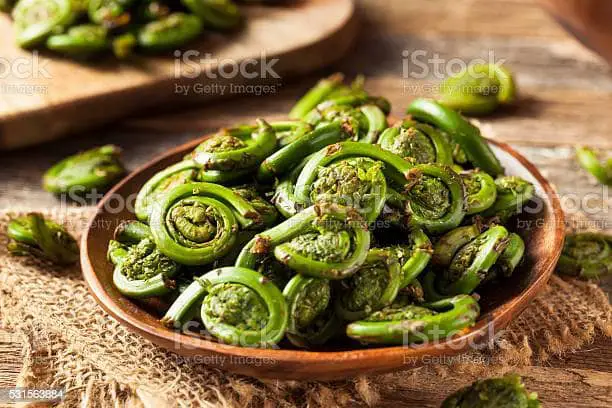Linguda ki sabji recipe, fiddleheads coffee, fiddlehead coffee menu, Unique farming ideas in Uttarakhand, India
Today I will help you to enhance your knowledge about Linguda which is well known as Fiddlehead in english. In this post I will share linguda vegetable dish recipe, possibility of linguda coffee
Lets dive in deeper
People might not be aware of this vegetable because its rare to find in common places. And this is my motive to write on linguda to make people aware about this delicious and healthy crop.
Linguda is unique but traditional vegetable. People who lives in hill areas must have seen this at least once. Especially people who belongs to Uttarakhand, Himachal Pradesh, Assam, Jammu etc.
In Garhwal region of Uttarakhand it is known as languda, in Darjling and Sikkim it is called niyuro, in Assam it is known as dhekia xak, in Tripura it is known as Muikhonchok and in Kullu valley of Himachal it is known as lingri where pickle lingri ka achaar is popular. It is known as limbra in Kumaon region of Uttarakhand.

Linguda
In Uttarakhand linguda sabji (vegetable) is quite famous and lingdi pickle is also delcious when it comes about taste. While searching on internet 'Lingoda in english' you will find it is called "Fiddlehead". Linguda is found in jungles it is not cultivated yet its a natural growing crop which grows itself in rainy season starting from the month of May you can find it till September. It usually grows near ponds and lakes. Price of 1 kg fiddlehead falls between Rs 15 - 30, Rs 40 - 80, Rs 80 - 120 prices vary according to the quality and the season. However, pickles are higher in price Rs 200 - 500 per/kg above Rs 500 as well.
Before I start sharing linguda recipe I need to share a very short story with you. Fiddleheads are found in the rainy season near lakes in hill areas. It is a difficult task for village farmers; first, they have to identify the actual fiddlehead because it is not grown at homes it is a jungle crop which is grown naturally in the jungle and one can get confused while detaching it because linguda is also of two types one is not eatable (poisonous) and other is eatable. Secoundly, they have to look after lots of leeches as well that are present near fiddlehead as fiddlehead generally grows in rainy-season thus leeches are also the species that are found in the rainy season especially around lakes and ponds. So it becomes more difficult for farmers first to identify then they also have to rescue the leeches.

lingudas
Fiddleheads are really delicious and it is very easy to cook such vegetable, it is also time saving dish which takes around 15 minutes to get ready. Everybody has own cooking style you can try this method once. You can eat this with simple chapati, paratha or chainsa bhaat (pulses with rice). Chainsa is a type of daal which is another traditional dish of Uttarakhand.
Step by step
First no need to wash at the beginning because it is gummy and sticky so it becomes more difficult to hold or grip, if you will wet it before cutting therefore just take a knife and start removing the fibers it becomes more easy due to its long stems curved posture may irritate you but its not long curve so it is also manageable. You can also use your hands for removing the same. This is necessary because by this process you can remove lots of dirt.
While cutting fiddlehead you may get the feeling of cutting beans because both have fibers to remove so if you have ever made beans then it will be more easier for you to cut and clean fiddlehead. Moreover, it is important to wash the fiddlehead after cutting due to its sticky and gummy skin.
Cut linguda's in small pieces like beans. You can add one onion with it.
Once cutting is done you can wash it by scrubbing with both the hands. Need to wash it twice if found more dirty. According to quantity (approx half kg 1 glass water) add a glass of water and one table spoon salt then boil it for 10 minutes. Boiling process is necessary to reduce the stickiness of the fiddleheads.
while boiling cover it with a lid and after boiling for 10 minutes it will become much softer means ready to eat. Now put a pan on gas add some oil according to your taste add garlic then add small pieces of onion. Start mixing all with a bigger spoon then wait for 5 - 8 minutes until onions get some shade its up to you weather you want onions to get dark brown or bit shady after that add boiled linguda's (fiddleheads) and mix well with other ingredient's. Remember you have to perform this exercise in low flame so that it couldn't loose the real element.

John Doe
Nice Indian traditional recipe..
Add some salt, kashmeeri red chilly, you can add green chilies instead of adding red, and garam masalas including little turmeric add all these ingredients as per your taste as you generally adds while making other vegetables. After mixing all cover it with a lid and wait for 6-8 minutes so that it could be well steamed. Now fiddleheads or linguda are ready to eat and ready to serve.
Best time to grow fiddlehead ferns
Early springs are the best time to plant fiddlehead and it becomes more relevant when you are living in northen areas or hill areas.

Fiddlehead Coffee Menu
Fiddlehead is also used to make Coffees. It might not much popular in India but in western Countries it is more popular and terms are used as fiddlehead coffee hours especially in European countries.
While talking about fiddlehead coffee company one can find them near any local market where fiddlehead coffee menu is available for you to choose your favourite coffee.

